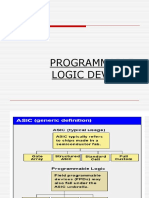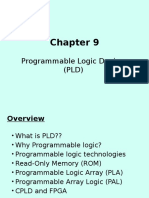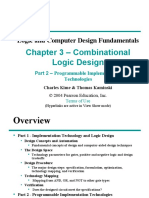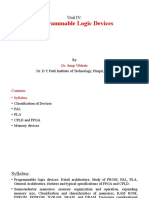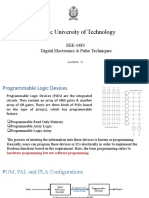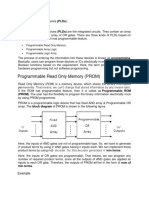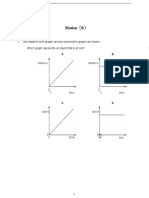Prepared by: Engr. Mary Jane B.
Becite
PROGRAMMABLE
LOGIC DEVICES
�Programmable Logic
Devices
Programmable Logic Devices (PLDs) are IC chips
with internal logic gates connected by electronic
fuses.
These fuses can be blown (by programming) to
obtain different circuit configurations.
Three classes of PLDs are :
Programmable Logic Array (PLA)
Programmable Read Only Memory (PROM)
Programmable Array Logic (PAL)
�Programmable Logic
Devices
Fixed
AND array
Inputs
Fuses
Fused
programmable
OR array
Outputs
Programmable Read Only Memory (PROM)
Fuses
Inputs
Fused
programmable
AND array
Fixed
OR array
Outputs
Programmable Array Logic (PAL)
Fuses
Inputs
Fused
programmable
AND array
Fuses
Fused
programmable
OR array
Programmable Logic Array (PLA)
Outputs
�Programmable Logic
Devices
Programming an array blowing the fuses.
A A' B B'
A A' B B'
(a) Unprogrammed
x1
x1 = A.B
x2
x2 = A'.B
x3
x3 = A.B'
(b) Programmed
Example of a basic AND array
�Programmable Logic
Devices
PLDs use diodes. A PN diode is an electronic device
formed by creating a junction of two types of semiconductor materials, p type and n type.
Forward-biased: When p side (anode) is more
positive than n side (cathode), it behaves as a
closed switch.
Reverse-biased: When cathode is more positive
than anode, it behaves as an open circuit.
P
Forward-biased (closed circuit)
PN junction diode and
schematic symbol.
Reverse-biased (open circuit)
�PN Diode Operation
PN diode operation for digital applications.
(a) With pull-up resistor.
(b) Reverse-biased: diode open; B pulled
up to 1.
(c) Forward-biased: diode shorted, forcing
B to 0.
(d) With pull-down resistor.
(e) Reverse-biased: diode open; B
pulled down to 0.
(f) Forward-biased: diode shorted,
forcing B to 1.
�AND Logic Arrays
AND function realised with a diode array.
(a) Basic configuration.
(b) All diodes open; f pulled up to 1.
(c) One diode shorted, forcing f to 0.
(d) Multiple diodes shorted, forcing f to 0.
�OR Logic Arrays
OR function realised with a diode array.
(a) Basic configuration.
(b) All diodes open; f pulled up to 0.
(c) One diode shorted, forcing f to 1.
�Two-level AND-OR
Arrays
AND and OR circuits can be interconnected to realise
any arbitrary switching function.
Example: f(a,b,c)=a.b.c'+b'.c
�Programmable Logic Array (PLA)
Combination of a programmable AND array followed
by a programmable OR array.
Example: Design a PLA to realise the following three
logic functions and show the internal connections.
f1(A,B,C,D,E) = A'.B'.D' + B'.C.D' + A'.B.C.D.E'
f2(A,B,C,D,E) = A'.B.E + B'.C.D'.E
f3(A,B,C,D,E) = A'.B'.D' + B'.C'.D'.E + A'.B.C.D
�Realising Logic Functions with PLAs
X
B
X
X
X
X
X
X
X
D
X
X
X
Programmable
AND array
Programmable
OR array
f1
X
P1
A'B'D'
P2
P3
P4
f2
P5
P6
P7
A'BCDE'
B'CD'E
A'BCD
B'CD'
A'BE
B'C'D'E
f3
f1(A,B,C,D,E) = A'.B'.D' +
B'.C.D' + A'.B.C.D.E'
f2(A,B,C,D,E) = A'.B.E +
B'.C.D'.E
f3(A,B,C,D,E) = A'.B'.D' +
B'.C'.D'.E + A'.B.C.D
�Read-Only Memory
(ROM)
A semi-conductor memory is a device where data can
be stored and retrieved.
Logically, this memory device can be regarded as a
table of memory cells (data).
Addresses
0
1
2
3
:
:
:
:
n
1-word data
:
:
word size
1-bit data
�Read-Only Memory (ROM)
A Read-Only Memory (ROM) is a memory device
where data are read from, but not written to.
Writing is done at time of customisation, or, by
special programming devices (programmable ROM).
Any Boolean expression can be implemented using
ROM. Procedure: Obtain a truth table, treat the
inputs as addresses and outputs as data.
Advantage: Boolean functions directly implemented.
Disadvantages: Dont care conditions not used, and
limited input variables (e.g. 10 inputs 1K, 16 inputs
64K, 20 inputs 1M).
�Read-Only Memory
(ROM)
Different types of ROM devices available:
ROM: Read-Only Memory
Data written into memory by mask programming
during manufacturing time. Expensive start-up cost
but economical for high volume. Cannot be erased
after data are programmed in.
PROM: Programmable ROM
Semi-custom chip. Fuses can be broken by
special hardware programmer unit. Cost-effective
for low volumes. Cannot be erased after
programming.
�Read-Only Memory
(ROM)
EPROM: Erasable PROM
Similar to PROM except that data can be
completely erased by exposure to ultra-violet
light.
EEPROM: Electrically Erasable PROM
A PROM where data can be selectively erased
by hardware programmer unit, rather than by
ultra-violet light. Useful for remote devices which
can be re-programmed from a distance.
�Programmable Read-Only
Memory (PROM)
Devices with fixed AND array (which is a decoder)
and programmable OR array.
The AND array (decoder) generates all 2n possible
minterm products of its n inputs (often referred to
as n-to-2n decoder).
n input lines, m output lines.
Bit combination of input variables address
Bit combination of output lines word (each word
contains m bits).
�Programmable Read-Only
Memory (PROM)
X
I1
I2
Programmable
OR array
X
X
X
X
X
X
X
X
X
X
X
X
X
X
Fixed
AND array
I0
O1
O2
..
.
Ok
..
.
m0
m1
m2
m3
m4
Minterms
m5
m6
m7
Programmable read-only memory (PROM) can realize K functions f(I 2,I1,I0).
�Programmable Read-Only
Memory (PROM)
n inputs
2n x m ROM
m outputs
2n x m ROM
=> 2n words, each word m bits
=> 2n x m bits
�Programmable Read-Only
Memory (PROM)
Minterms
Address
input
A0
A1
A2
A3
A4
5 x 32
decoder
0
1
2
31
.
.
.
...
...
...
...
128 fuses
Logic construction of a 32 x 4 ROM.
F1
F2
F3
F4
�Realising Logic Functions with
PROMs
Example (8x3 ROM):
f1(A,B,C) = A.B + B'.C
f2(A,B,C) = (A+B'+C).(A'+B)
f3(A,B,C) = A + B.C
First, we convert each function to canonical SOP form.
f1(A,B,C) = A.B + B'.C = A.B.C' + A.B.C + A'.B'.C + A.B'.C
= m(1,5,6,7)
f2(A,B,C) = (A+B'+C).(A'+B)
= (A+B'+B).(A'+B+C').(A'+B+C)
= M(2,4,5) = m(0,1,3,6,7)
f3(A,B,C) = A + B.C = A.B'.C' + A.B'.C + A.B.C' + A.B.C + A'.B.C
= m(3,4,5,6,7)
�Realising Logic Functions with
PROMs
X
X
X
B
X
Programmable
OR array
X
X
X
X
X
m1
X
X
f1 = m(1,5,6,7)
f2 = m(0,1,3,6,7)
f3 = m(3,4,5,6,7)
m6
m7
X
X
m0
X
X
m2
X
X
X
X
X
m3 m4 m5
Minterms
Fixed
AND array
�Realising Logic Functions with
PROMs
Minterms
Address
input
C
B
A
8 x 3 ROM
0:
1:
2:
3:
4:
5:
6:
7:
0
1
0
0
0
1
1
1
1
1
0
1
0
0
1
1
0
0
0
1
1
1
1
1
3x8
decoder
0
1
2
3
4
5
6
7
f1 = m(1,5,6,7)
f3 = m(3,4,5,6,7)
f2 = m(0,1,3,6,7)
�Programmable Array Logic (PAL)
Introduced in late 1970s by Monolithic Memories
Inc. as lower cost replacement for logic gates,
PROMs, and PLAs.
PAL has programmable AND array and fixed OR
array.
Less general than PLA but easier to manufacture
and design.
Product terms belong to different OR gates,
cannot be shared.
�Programmable Array Logic (PAL)
A
P1
P2
O1
P3
P4
P5
O2
P6
Programmable AND
array
Fixed
OR array
�Realising Logic Functions with PALs
Procedure is to obtain minimal SOP expressions.
Example:
f(A,B,C,D) = A'.B'.D' + B'.C.D' +
A'.B.C.D
f(A,B,C,D) = A'.B + B'.C.D'
f(A,B,C,D) = A'.B'.D' + B'.C'.D' +
A'.B.C.D
�Realising Logic Functions with
PALs
f(A,B,C,D) = A'.B'.D' + B'.C.D'
+ A'.B.C.D
f(A,B,C,D) = A'.B + B'.C.D'
f(A,B,C,D) = A'.B'.D' + B'.C'.D'
+ A'.B.C.D
P1
P3
P4
x
x
x
P5
P6
x x
x x
P4
x
x x
x x
x
P5
x
P2
P6
PAL realisation
of fa, f and fr.
x
x
x
x


